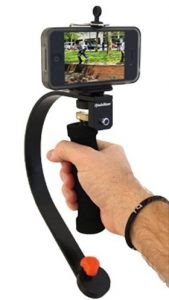
How to create professional video using your cell phone

6 min read
Smartphones with a great camera and the ability to record high definition videos are no longer difficult to find they’re everywhere. Professional video content creators are finding that using their mobile phones to shoot video has several significant advantages:
Mobile phones are ubiquitous, and we almost always have our phones with us. Quickly and spontaneously capturing video content doesn’t require lugging around large video cameras when an unexpected opportunity presents itself.- Many apps are available for both iOS (Apple) and Android (Google) mobile devices that extend the functionality of the video camera, provide sophisticated editing and digital effects capabilities, as well as provide a way to upload finished videos for distribution and viewing immediately.
- Perhaps most importantly, as the phones have become more capable, video entrepreneurs are finding that getting into entrepreneurial filmmaking is much more affordable, too.
However, while it is good to have a smartphone with an awesome camera, using poor video making technique will probably result in a poor video product. Just because you have a very expensive hammer, with all of the features money can buy, it doesn’t guarantee that you will build a magnificent home without practice and good video technique.
Your video does not have to be perfect but following these seven tips, shooting great video with your smartphone will be easy and the footage will look fantastic!
#1 – Good Lighting is Critical
Proper lighting has a huge impact on smartphone cameras because they have smaller image sensors and lenses. Try as much as possible to shoot your video in brightly lit areas. This will help avoid unnecessary shadows and grainy areas in your video. Conversely, you also must be careful not to point the camera directly at bright light sources, which will cause unusable overexposed footage and lens flaring. Lighting should be stable and steady; the image sensors in most smartphones do not react to dramatic changes in lighting very quickly. If the light is still making it tough to shoot your video try working with back-lighting and white balance settings if your phone or app provides them. Most phones also offer “touch focusing” in the event your camera is focusing on the wrong area of your composition. After setting the focus on the most important aspect of the video, the automatic exposure control will have an easier time making small adjustments if the lighting condition begins to change.
#2 – Stay Steady

If you don’t want your video footage to come out distorted, blurred, or affected by “rolling shutter” the best thing to do is to keep your phone steady while recording. Use both hands to hold your smartphone as close as possible to your body as you record the video. This can be a bit fatiguing in long takes or sequences, and there are other ways to support the phone:
- Stabilizers, tripods, and camera cages allow you to keep your smartphone or mobile device still when taking a video with it; they have perfect handles to accomplish this.
- If a smartphone tripod or stabilizer is a little too costly or not practical for you in your circumstances, you can rest your phone on other physical supports like tables, chairs, desks, shelves, etc.
#3 – The Audio Matters as Much as the Video
A good video with poor audio quality is junk unless you plan to add a completely new audio track “in a post” (while editing your video). While you want your video to look good, the quality of your audio is more important than the video – so it should matter as much, if not more. Unfortunately, the built-in microphone in most smartphones (if not all of them) is both low quality and improperly placed. It is very common to catch the wind and unnecessary environmental noise that will compete with or drown out any important audio while shooting video outside. This is almost impossible to edit out later. It is advisable to shoot your video in a quiet place, preferably indoors when possible with less ambient noise. Professionals are shooting all sorts of commercial grade videos and feature films using their mobile phones, but the audio is almost ALWAYS captured with a separate recording device suitable for the job. So, for exceptional quality videos with superb audio, you should get an external recording device or at least a directional microphone that will work with your smartphone. If using an external microphone isn’t possible or practical then stay as close to the audio source as possible and try this little trick: use your hand to cover around the phone’s microphone (but don’t completely cover it). This way, unwanted noise can be reduced, which might give your final product a chance.
Why Audio is More Important Than Video Image Quality
#4 – Get Close to Your Subject
Staying physically closer to your subject ensures better image quality, less digital noise, and better focus in your videos since most smartphones use a digital zoom rather than optical zoom. If your video requires super zoom close-ups of tiny details, they make clip-on macro lenses that will fit any iPhone or Android smartphones.
#5 – Avoid Vertical Video Syndrome
I really cannot drive this point home well enough. Stop shooting vertical video! Some videographers, (yes… video entrepreneurs, too) who use their smartphones for digital filmmaking often make the mistake of holding their phones vertically, that is to say up and down rather than sideways while recording.
Hold your phone horizontally so that videos played back on other screens (virtually everywhere) will look fine.
#6 – Improve Your Videos with Mobile Apps
The camera app on your smartphone may do a good job, but there’s more to video recording than what most of them have to offer! Some third-party apps are very intuitive with great features for those new to developing video content while some others unlock professional-like features that might bring out your inner George Lucas. While you will find some pretty good free apps, investing in a couple of apps that cost a little bit of money can pay huge dividends.
We have a rundown of 8 of our favorite iOS apps to make your videos with iPhone and iPad better here.
#7 – Be Prepared for the Shoot
Before you begin recording your videos, make sure that you have all of the gear, props, scripts, actors, and shooting locations ready to go. Additionally, make sure your phone an excellent and that you have enough storage space (available memory) to store the footage – high definition (HD) video files can get large and will drain a battery quickly.
This video by Filmic Pro “5 Things to Do Before You Shoot iPhone Video” covers much of what we’ve discussed, too: memory storage, battery life, audio, and resolution, but they add a great point; you have to think about stabilization, and they’ve included a few great options for obtaining steady video:
Producing great videos can be a fun and lucrative pursuit for entrepreneurial-minded filmmakers. Master the art of videography with your smartphone by following these tips. Through practice, trial, and error and you will start seeing professional results in no time!
Are you looking for apps and device-specific tips for iOS and Android mobile devices? Check out the following links:
- iOS video editing apps for your iPhone or iPad.
- Getting professional results shooting video with your iPad.
- Video recording and editing apps for Android smartphones, tablets, and other mobile devices.
Get Better Audio While Shooting Video with Your Smartphone or Mobile Camera
What tips or bits of advice would you give to other filmmakers who are using their mobile phones to record video? Do you have a particular iOS or Android app you cannot live without? Tell us in the comments below!


